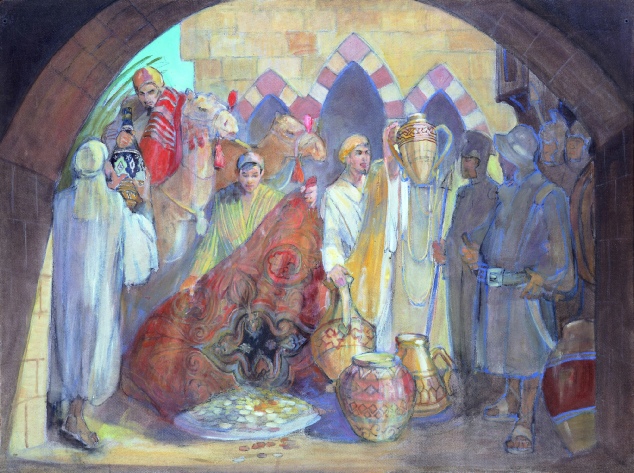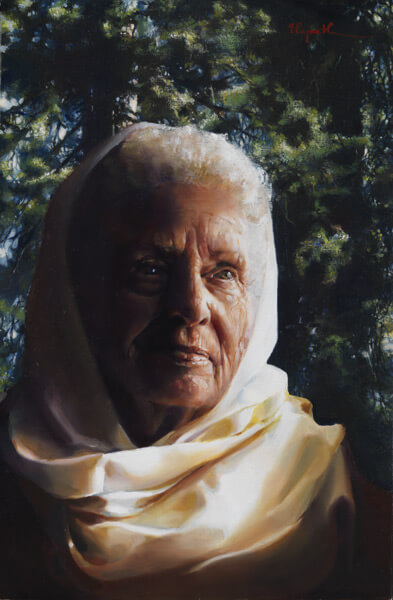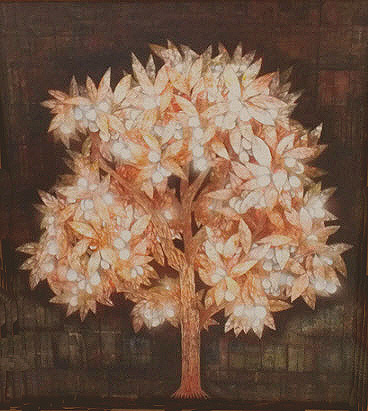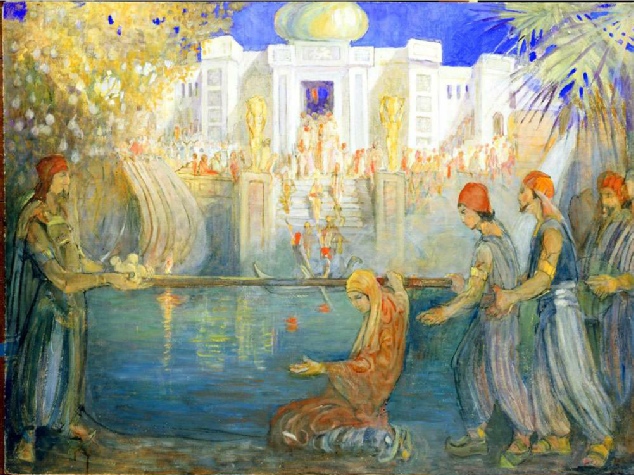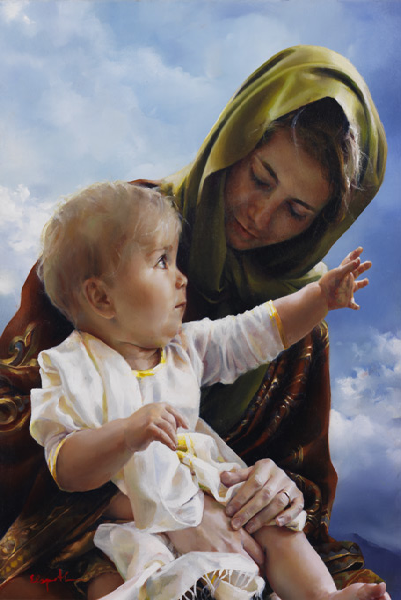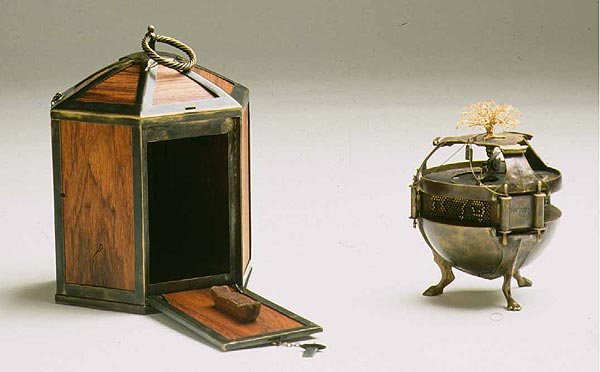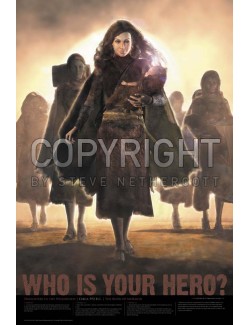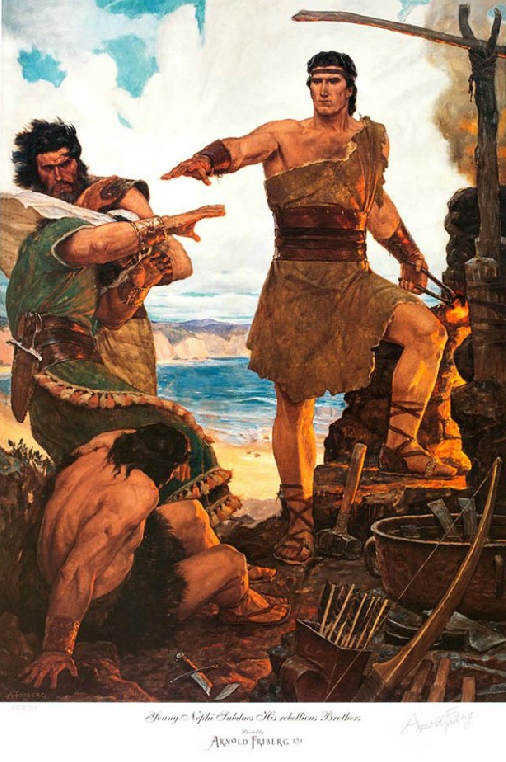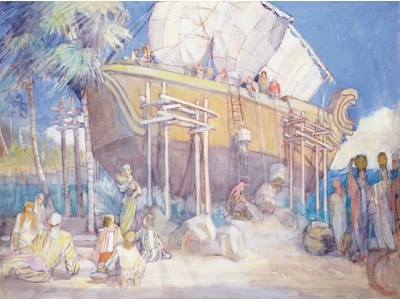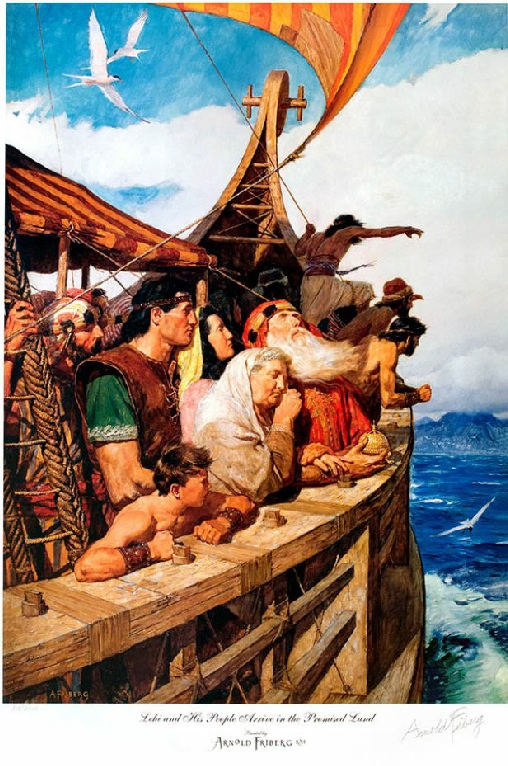






Book of Mormon Feast
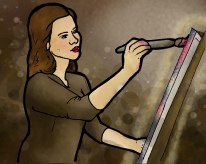
An Artistic Tour Through 1 Nephi
1 Nephi 1:1
BOOK OF MORMON MUSIC
“We’ll Bring the World His Truth” – by Janice Kapp Perry
Nephi says that he was born of goodly parents and he knows the goodness of God,
therefore he wrote a record which brings truth to the world. Acapella group Inside
Out illustrates the song with pictures of Latter-
Children’s Songbook, 172
1 Nephi 2:15
BOOK OF MORMON POETRY
“And My Father Dwelt in a Tent,” -
1 Nephi 3:1-
BOOK OF MORMON MUSIC
“Nephi’s Courage” – Bill N. Hansen Jr. & Lisa T. Hansen
The Lord gave Nephi’s family a difficult assignment: return to Jerusalem and acquire the plates of brass, the history of his people, which was kept by a wealthy relative. Nephi’s brother complained, but Nephi expressed his faith: “I will go and do the things which the Lord hath commanded, for I know that the Lord giveth no commandment unto the children of men, save he shall prepare a way for them that they may accomplish the thing which he commandeth them.”
This Linda Mat Kids presentation is illustrated.
Children’s Songbook, 120
1 Nephi 3:24
BOOK OF MORMON ART
Treasures in Exchange for the Plates of Brass
Minerva Teichert
Lehi’s sons’s second attempt to get the Plates of Brass, as commanded by the Lord: “And it came to pass that we went in unto Laban, and desired him that he would give unto us the records which were engraven upon the plates of brass, for which we would give unto him our gold, and our silver, and all our precious things.”
1 Nephi 4:6
BOOK OF MORMON ART
Not Knowing Beforehand – Elspeth Young
“And I was led by the Spirit, not knowing beforehand the things which I should do.” Thus Nephi describes his final successful acquisition of the plates of brass, as directed by the Lord.
In the Book of Mormon, young Nephi and his brothers have the commission to obtain the sacred record, so that their descendants will know the commandments of the Lord. They’ve unsuccessfully tried several ways to obtain them, and Nephi knows that he can only rely upon the Lord for help, because he is on the Lord’s errand.
1 Nephi 4:7-
BOOK OF MORMON ART
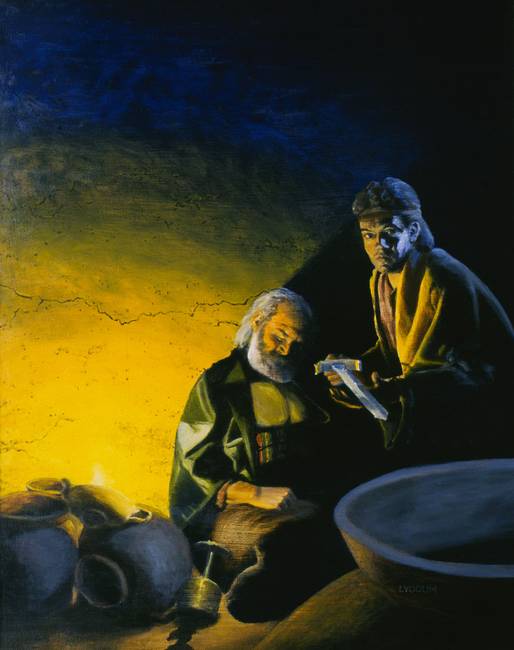
“Nephi and Laban” – Lester Yocum
“Nevertheless I went forth, and as I came near unto the house of Laban I beheld a man, and he had fallen to the earth before me, for he was drunken with wine. And when I came to him I found that it was Laban. And I beheld his sword, and I drew it forth from the sheath thereof.”
Artist’s notes:
“Nephi ponders what to do with the man who has done so much harm to his family, now found drunk and helpless in an alley at night.”
1 Nephi 4:10-
BOOK OF MORMON ART
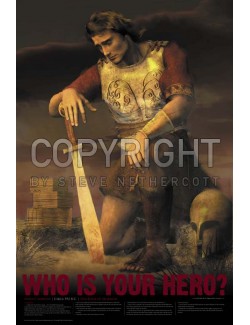
“Nephi’s Sorrow” – Real Heroes Posters – Steve Nethercott
Nephi faced a dilemma – to stay in his comfort zone, or to do a difficult thing that the Lord was commanding him. The Book of Mormon says,
“And it came to pass that I was constrained by the Spirit that I should kill Laban; but I said in my heart: Never at any time have I shed the blood of man. And I shrunk and would that I might not slay him.
“And the Spirit said unto me again: Behold the Lord hath delivered him into thy hands.
“Yea, and I also knew that he had sought to take away mine own life; yea, and he would not hearken unto the commandments of the Lord; and he also had taken away our property.
“And it came to pass that the Spirit said unto me again: Slay him, for the Lord hath delivered him into thy hands. Behold the Lord slayeth the wicked to bring forth his righteous purposes. It is better that one man should perish than that a nation should dwindle and perish in unbelief.”
1 Nephi 5:8
BOOK OF MORMON ART
The Promised Land {Sariah} – Elspeth Young
Artist’s Comments:
The story behind The Promised Land
The Book of Mormon begins with an account of the family of Lehi, a prophet living
in Jerusalem during Zedekiah’s reign in 600 BC (1 Nephi 1:4). Lehi is commanded by
the Lord "that he should take his family and depart into the wilderness…wherefore,
he did as the Lord commanded him...And he left his house, and the land of his inheritance,
and his gold, and his silver, and his precious things, and took nothing with him,
save it were his family, and provisions, and tents, and departed into the wilderness"
(1 Nephi 2:2-
During the family’s wilderness journey, Lehi dreams a dream in which he sees the
tree of life "whose fruit was desirable to make one happy" (1 Nephi 8:10). This
tree and its fruit represent the "love of God" (1 Nephi 11:22). In this dream, Lehi
partakes of the fruit and then invites his family (including his wife Sariah) to
partake of the fruit also, which they do (see 1 Nephi 8:13-
As mother to both the Nephite and Lamanite races, Sariah is a mother of nations. The differences between the two races are symbolized by the stark contrast visible in her face.
1 Nephi 8
BOOK OF MORMON MUSIC
“The Iron Rod” – Joseph L. Townsend & William Clayson
In Lehi’s powerful and visually descriptive vision of the Tree of Life, he saw an iron rod that led to the tree. The iron rod is the word of God, and “whoso would hearken unto the word of God, and would hold fast unto it, they would never perish; neither could the temptations and the fiery darts of the adversary overpower them unto blindness, to lead them away to destruction.”
A Priesthood Choir from BYU, under the direction of Ronald Staheli, performed “The
Iron Rod” at the Priesthood Session of the April 2010 General Conference of the Church
of Jesus Christ of Latter-
1 Nephi 8:2
BOOK OF MORMON ART
“Behold, I have dreamed a dream, or in other words, I have seen a vision.”
Thus Lehi introduces one of the most memorable and spiritually impressive scenes in the Book of Mormon, now referred to as the Tree of Life vision.
This Liahona article combines a number of beautiful interpretations by various artists of Lehi’s Tree of Life vision.
1 Nephi 8:11
BOOK OF MORMON ART
“Tree of Life” – Kazuto Uota
This stunning artistic work by Kazuto Uota was created in 1990. It represents the Tree of Life as described in the Book of Mormon, with its fruit glowing as it displays the power of God.
This work was featured on the cover of the Ensign magazine in August, 2010, and generated much favorable response from the Ensign readers.
1 Nephi 8:11,12
BOOK OF MORMON ART
“Lehi’s Dream” – Real Heroes Poster – Steve Nethercott
Speaking of the fruit of the Tree of Life, which represents the love of God, Lehi said, “I did go forth and partake of the fruit. . . it was most sweet . . . . It filled my soul with exceedingly great joy.”
Real people – real power. Real Hero Posters strives to capture the spirit of real heroes, the uniqueness of their world, the strength of their character, and the reality of their heroism.
1 Nephi 8:16
BOOK OF MORMON ART
Lehi’s Dream – Gary L. Kapp
Lehi’s vision of the Tree of Life is a memorable high-
Speaking of a part of them, the Book of Mormon records, “And it came to pass that they did come unto me and partake of the fruit also.”
1 Nephi 8:26,27
BOOK OF MORMON ART
Minerva Teichert
Lehi and Nephi saw the beautifully symbolic Tree of Life in vision, which represents the Love of God. The also saw a great and spacious building, filled with people mocking those who were partaking of the pure fruit of the Tree.
“In this representation of Lehi’s Dream from chapter 8 of the first book of Nephi, Teichert reverses traditional symbolism of light and dark. As in real life, the blessings of faith and obedience are sometimes not as immediately apparent or attractive as the entrapments of Satan.”
1 Nephi 11
BOOK OF MORMON MUSIC
“Nephi’s Vision of the Tree of Life” – Marilyn Arnold & Maurine Ozment
Sacred Hymns of the Book of Mormon, 18
After Lehi told his family of his amazing and wonderful vision of the Tree of Life, his son Nephi wanted to see the things that his father had seen. Because of his faith and faithfulness, the Lord blessed him with this desire, and he wrote extensively of the marvelous things he himself saw, all of which testify of the love of God.
1 Nephi 11:20,21
BOOK OF MORMON ART
Bearing a Child in Her Arms {Mary and the Christ Child} – Elspeth Young
Artist’s comments:
The story behind Bearing A Child In Her Arms
This painting represents a portion of the vision the prophet Nephi received concerning the life and mission of Jesus Christ "to bear record that he is the son of God" (1 Nephi 11:7).
After being shown the tree of life, Nephi requested to know the interpretation of that tree. Accordingly, Nephi was immediately shown a vision of a "virgin...bearing a child in her arms" and was told that that the infant was "the Lamb of God, yea, even the Son of the Eternal Father!" (1 Nephi 11:18, 21).
Upon seeing this, an angel questioned Nephi concerning the meaning of the tree of
life. Nephi accurately perceived that the tree of life, or Christ, "is the love of
God, which sheddeth itself abroad in the hearts of the children of men; wherefore,
it is the most desirable above all things...and the most joyous to the soul" (1 Nephi
11:22-
Indeed, the love of God has never been manifested so plainly to God's children as in the gift of His "only begotten Son, that whosoever believeth in him should not perish, but have everlasting life" (John 3:16).
This visual representation of this moment from Nephi's marvelous vision seeks also to testify of the reality and divinty of the Son of God.
Symbolism in Bearing A Child In Her Arms
The figures of Mary and the Infant Christ are depicted very clearly in the midst of an indistinct background. As befits Nephi's unwavering focus during the vision, there is nothing in the background to distract the viewer from the message in the vision. All elements, even color and light, point to the center of our existence, Jesus Christ, just as the Spirit of the Lord makes it clear to Nephi that the reason he was shown what his father saw was so that he could bear his own witness of Christ.
The Child is loosely wrapped in the type of "swaddling clothes" in which Mary wrapped
Him at His birth (see Luke 2:7). Other than the barest hint of a golden trim at the
edge of the garment, there is nothing distinctive about the cloth, save its whiteness.
Its brilliance symbolizes His purity-
The viewer is drawn to the Infant's penetrating gaze by the highlight in His eye,
contrasted with the dark shadows surrounding Him. Though partly enveloped in the
shadows of this world, His light is ever invincible. His mission was to descend below
all things and overcome the world-
Mary's countenance is also radiant, partly from the Heavenly light enveloping the two figures; partly reminding the viewer of Nephi's description her as "exceedingly fair and white...most beautiful and fair above all other virgins" (1 Nephi 11:13, 15). Her beauty borne of goodness is also echoed in the words of Alma, who called her "a precious and chosen vessel" (Alma 7:10).
Mary's hair is seen unveiled, a visual representation of her virginity. In her day, it was customary for maidens to show their hair in public as a sign of their chastity. This, among other cultural clues of apparel may have helped Nephi identify her as a virgin without any help from the angel.
Mary's dress is patterned on traditional Palestinian dress, or shinyar, a costume silhouette dating back 1500 BC. The embroidered ornamentation on its yoke and sleeves is typical of Israelite bridal costume, though it is intended here as another visual symbol of elements in Nephi's vision. The golden motifs embroidered on its sleeves are a tree of life symbol, while the red and gold banding beneath the trees represent the rod of iron which Nephi beheld leading, "to the fountain of living waters, or to the tree of life" (1 Nephi 11:25).
The vessel immediately behind the figures is an oil cask symbolizing the Savior's
mission as the Anointed One, sent to earth to "heal the broken-
1 Nephi 16:7
BOOK OF MORMON ART
I Will Go Before Your Face {A Daughter of Ishmael} -
Artist’s Comments:
The story behind I Will Go Before Your Face
"For behold, it came to pass that the Lord spake unto my father, yea even in a dream, and said unto him: Blessed art thou, Lehi, because of the things which thou hast done; and because thou hast been faithful and declared unto this people the things which I commanded thee, behold, they seek to take away thy life. And it came to pass that the Lord commanded my father, even in a dream, that he should take his family and depart into the wilderness. And it came to pass that he was obedient unto the word of the Lord. . . and it came to pass that he departed into the wilderness. And he left his house, and the land of his inheritance, and his gold, and his silver, and his precious, things, and took nothing with him, save it were his family, and provisions, and tents, and departed into the wilderness...
And it came to pass that the Lord commanded him that I, Nephi, and my brethren, should again return unto the land of Jerusalem, and bring down Ishmael and his family into the wilderness...And it came to pass that the we went up unto the house of Ishmael, and we did gain favor in the sight of Ishmael, insomuch that we did speak unto him the words of the Lord. And it came to pass that the Lord did soften the heart of Ishmael, and also his household, insomuch that they took their journey with us down into the wilderness to the tent of our father...
And it came to pass that I, Nephi, took one of the daughters of Ishmael to wife,
and also, my brethren took of the daughters of Ishmael to wife...And it came to pass
that we did again take our journey in the wilderness...And we did travel and wade
through much affliction in the wilderness, and our women did bear children in the
wilderness. And so great were the blessings of the Lord upon us, that while we did
live upon raw meat in the wilderness, our women did give plenty of suck for their
children, and were strong, yea, even like unto the men; and they began to bear their
journeyings without murmurings. And thus we see that the commandments
of God must be fulfilled. And if it so be that the children of men keep the commandments
of God he doth nourish them, and strengthen them, and provide means whereby they
can accomplish the thing which he has commanded them; wherefore, he did provide means
for us while we did sojourn in the wilderness...yea, even eight years...and notwithstanding
we had suffered many afflictions and much difficulty, yea, even so much that we cannot
write them all, we were exceedingly rejoiced when we came to the seashore..." 1
Nephi 2:1-
1 Nephi 16:10
BOOK OF MORMON ART
Lehi in the Wilderness Discovers the Liahona
Arnold Friberg
Thus far in the Book of Mormon story the family has been near their home in Jerusalem, in familiar territory. But as they were about to embark into the dry and desolate Arabian wilderness, the Lord provided them with an instrument which would guide them safely through.
“And it came to pass that as my father arose in the morning, and went forth to the tent door, to his great astonishment he beheld upon the ground a round ball of curious workmanship; and it was of fine brass. And within the ball were two spindles, and the one pointed the way whither we should go into the wilderness.”
Artist’s Note:
As might be expected when confront with subjects never before pictured, there were opinionated, personal versions on almost every detail. Little things like the color of Nephi’s hair were open to debate and everyone had an opinion.
A baffling question involved the picturing of the Liahona. Of course any reader of the Book of Mormon knows the very limited description of the instrument. To illustrate the problem between words and pictures, let us consider a speaker (perhaps a BYU professor) who is known as an expert on the Book of Mormon. Let’s call him Mr. Words. He delivers a speech on what a marvelous device was the Liahona. After the lecture come questions from the audience.
Question: “Just how large was the Liahona?
Speaker: “Oh, we’re not told that. But it was round and had these pointers inside”.
Question: “How did they see the pointers? Was there open work in the design for them to see through? Or was the top hinged to open up for viewing?”
Speaker “We are not told that either. But it was a wonderful instrument, working according to their faith.”
Question: “What did they do with it when not in use? Was there a bag or a stand to keep it in, or did they just let it roll around on the deck of the ship?”
Speaker “Oh, we’re just not told that. But it was of curious workmanship, etcetera.”
Now, Mr. Words hasn’t told us anything any reader of the book doesn’t already know. But he’s off the hook. He’s still an “expert” so to speak. Dealing only in such words as we read, he hasn’t had to really tangle with the answers. Now comes Mr. Pictures. He’s the artist, who doesn’t know the answers any more than Mr. Words or anyone else. But he can’t duck. No, he has to grit his teeth and paint something. There is no tube of oil paint Labeled ‘when you don’t know, use this’. So I painted something that seemed reasonable, of a size easily handled, and designed a suitable tripod to rest it on.
When asked “How do you know the Liahona was that size?”
I answered, “I don’t know.”
“Then how can you paint it that size if you don’t know?”
It was G.K. Chesterton who once said: ”Art, like morality, consists in drawing the line somewhere.”
At last I decided that an historical painting was not a wax-
1 Nephi 16:10
BOOK OF MORMON SCULPTURE
The Liahona – Lowell Fitt
Worked Metal and Wood. Fitt’s intricate Liahona, winner of the Church art competition of 1990, displays a tree of life on the top.
1 Nephi 16:17-
BOOK OF MORMON ART
Nephi Hunting – Steve Nethercott
As Lehi’s family traveled through the Arabian desert they had to provide food for
themselves. The Book of Mormon recounts an occasion when their principal bow broke.
Many in the party sat and complained, but Nephi made a new bow and arrow,
and, with direction from the Lord, was able to hunt and bring home much-
Real Heroes (Real people, Real power)
BOOK OF MORMON ART
Daughters in the Wilderness – Steve Nethercott
The Book of Mormon gives an idea of the difficulties Lehi’s family faced as they traveled through and lived in the Arabian desert for eight years. Nephi records, “And we did travel and wade through much affliction in the wilderness; and our women did bear children in the wilderness. And so great were the blessings of the Lord upon us, that while we did live upon raw meat in the wilderness, our women did give plenty of suck for their children, and were strong, yea, even like unto the men; and they began to bear their journeyings without murmurings.”
Real Heroes Poster, (Real People – Real Strength)
1 Nephi 17:8-
BOOK OF MORMON MUSIC
“Nephi’s Courage” – Bill N. Hansen Jr. & Lisa T. Hansen
The Lord gave Nephi’s family another challenge on their quest to find and inherit the Promised Land: build a boat to cross the great waters. While his brother complained and mocked him, Nephi’s only question was “Where shall I go to find ore to make tools?” He did not doubt that the Lord would help him.
Enjoy Ryan Heywood’s haunting base vocal presentation of this song, accompanying himself on the guitar.
Children’s Songbook, 120
1 Nephi 17:53
BOOK OF MORMON ART
Young Nephi Subdues His Rebellious Brothers
Arnold Friberg
The Lord gave Nephi instructions on how to build the ship, but he needed his brothers’ labor as well. They didn’t want to work for little brother, and did not believe that they would be able to build a ship. After the Lord gave them a sign they could understand, then they put their hands to the work:
“And it came to pass that the Lord said unto me: Stretch for thine hand again unto thy brethren, and they shall not wither before thee, but I will shock them, saith the Lord, and this will I do, that they may know that I am the Lord their God.”
Artist’s Notes:
“In YOUNG NEPHI SUBDUES HIS REBELLIOUS BROTHERS, Nephi is in the very first stage of building a ship. Building a ship!!! Of course his brothers thought he had taken grandiose leave of his senses. Before construction could begin, Nephi had to take ore from the mountain and build a primitive forge to make the tools to build the ship. Talk about starting from scratch! Since we don’t know what Nephi looked like, I of course couldn’t paint a portrait. So what I did paint was the image of a man who looks as though he could do what Nephi did. This, of course, required quite a man. I made Nephi strong, not only in body but in spiritual power, as his bullying brothers soon learned.”
1 Nephi 18:4
BOOK OF MORMON MUSIC
“Nephi’s Courage” – Bill N. Hansen Jr. & Lisa T. Hansen
Nephi was successful in building the boat to carry his family to the promised land, as he knew he would be, because he was instructed of the Lord, and followed those directions.
Front Porch Acappella presents an informal mashup of this song, preparing for a ward event.
Children’s Songbook, 120
1 Nephi 18:6
BOOK OF MORMON ART
Minerva Teichert
“The ship that will carry Lehi’s family to the promised land fills the center of the picture. The scene is calm and purposeful, with the men hoisting provisions and the women waiting to board. At the right, three graceful women carrying jars resemble a row of Greek statues, while a woman at the left holds her child in a pose like a madonna. As the artist developed the final version of the scene, she added distinctive details of “curious workmanship” to the ship (1 Nephi 18:1), including an unusual prow and sails sewn together from many small pieces of fabric. Although propped firmly in place, the ship leans toward rough seas. Its sails billow lightly as though it is about to move toward the clouds beyond the horizon–a foreshadowing that the faith impelling the family to build a ship and sail it to an unknown land will be tested.”
1 Nephi 18:22,23
BOOK OF MORMON MUSIC
“An Angel Came to Joseph Smith” – Anna Johnson & A. Laurence Lyon
Lehi’s family has arrived in the Promised Land – America. The rest of the Book of Mormon describes the spiritual history of this great civilization until its downfall a thousand years later. The Lord delivered this record to our civilization by an angel, and we can read about and learn from these people, and their triumphs and failures.
Children’s Songbook, 86
1 Nephi 18:23
BOOK OF MORMON ART
Lehi and His People Arrive in the Promised Land
Arnold Friberg, 1913-
After troubles upon the water, Lehi’s family finally arrives at the Promised Land, where they will settle and grow and spread.
Artist’s Notes:
The question when painting LEHI AND HIS PEOPLE ARRIVE IN THE PROMISED LAND was, how to picture Nephi’s ship. In the Book of Mormon we read the puzzling words that it was not built after the manner of men. So what did it look like? Again, Mr. Words can duck, but Mr. Pictures can’t. He must paint something that somehow satisfies us as looking real and reasonable. Faced with this decision, I reasoned that God, who works by natural laws, not in defiance of them, isn’t going to instruct Nephi to build a bizarre oddity defying all engineering logic, just to be different from man’s usual designs. Just to conjecture, God’s instructions to Nephi might have revealed something merely in advance of its time, unknown in that period of ship building. Possibly such a simple thing as the steering rudder, not yet invented in Nephi’s time, might have made his ship “not after the manner of men.” At least we may be sure that they did have sails. For we are told they “were driven forth before the wind.”
In the picture of the ship’s arrival in the promised land, I added a bit of interesting
detail: the flying birds are not seagulls. They are the swallow-
1 Nephi 18:24
BOOK OF MORMON ART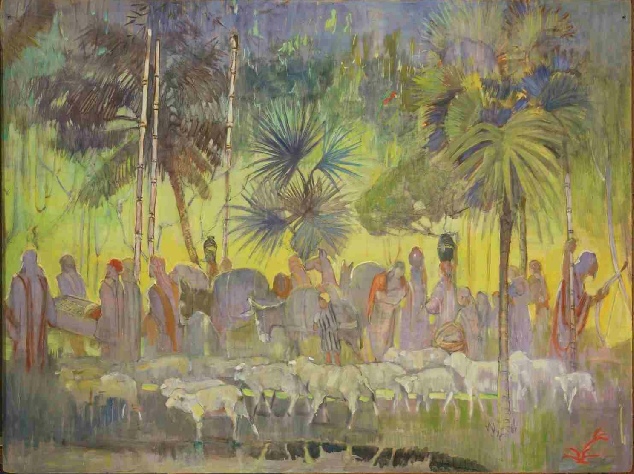
Minerva Teichert
The Book of Mormon records the joy and excitement when Lehi’s family began to explore their new home, the Promised Land, which we now call America.
